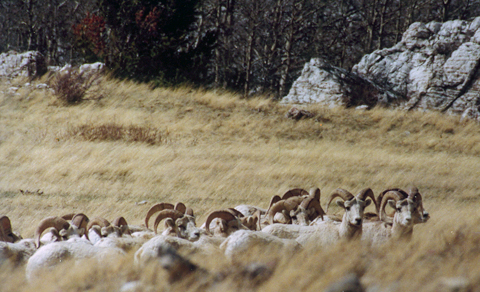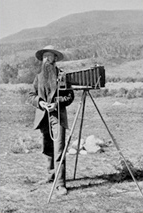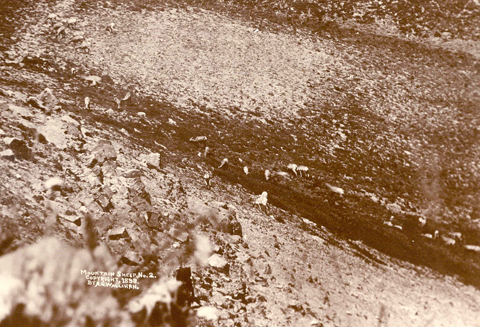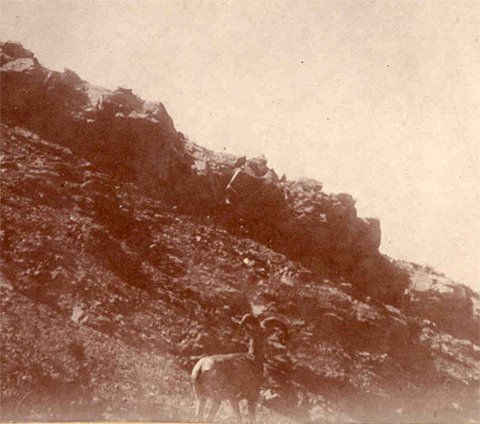Kottman’s Herd
A few of the nearer animals in this band of rams peer over the rumps of several heads-down grazers toward photographer Eric Kottmann, as if to estimate the degree of threat he might pose.
Bighorns are able to spot movements as much as 1,000 yards distant, but their vision is not good at resolving lines or shapes. If an intruder holds still they will stare at him for ten to twenty seconds, then either resume feeding or move away. They can smell a human 350 upwind yards away.[1]Geist, Mountain Sheep, 12-13.
These wild sheep were crossing a meadow on the lower eastern slope of Castle Reef Mountain west of Augusta, Montana, in mid-March, 1994. Lewis passed within sight of that mountain in late July 1806 on his exploration of the shortcut between Travelers’ Rest and White Bear Islands, but he didn’t mention seeing any of this herd’s ancestors.
Seasonally, as forage changes, bighorns migrate from precipitous rocky ridges and cliffs, or alpine meadows, to grassy valley floors, ranging perhaps 20 miles or more. When competitors challenge them, they nimbly retire to less accessible realms. Today their migratory habit accounts for the relatively high mortality rate from collisions with vehicles wherever their travel routes cross public highways.
For example, historically there has been a herd of bighorns numbering as many as 200 head that range across Montana Highway 200 near Thompson Falls, in the heart of the Northern Rockies. Each spring they descend from the nearby cliffs to graze on the green grass along the road’s shoulders. In winter they congregate on the pavement to lick the salt-based mixture that maintenance crews use to de-ice the tortuous two-lane mountain highway. Their need for salt being greater than their fear of motor vehicles, they periodically stop traffic. Most traffic, that is. An average of more than 16 bighorns have been struck and killed every year since record keeping began in 1985. However, on the morning of 10 November 2007, the driver of a trailerless semi truck from Butte nominated himself for a Meanest-Man-of-the-Year trophy. He ignored the warning on the flashing readerboard sign at the east end of a straight stretch, and barreled at full highway speed through a herd of about 50 bighorns, some probably weighing upwards of 200 pounds. He killed at least seven instantly. More may have died later from injuries. Down the road a ways he stopped his blood-spattered truck at a state Fish, Wildlife and Parks hunter checkpoint to complain about the damage the sheep had done to the bumper, a headlight, and the right fender of his vehicle. He didn’t seem to regret having raised the calendar year’s kill-count from 18 to 25 within a space of about two seconds.[2]Vince Devlin, “Bighorn Blockade,” Missoulian.com, Friday, 30 November 2007.
Wallihan’s First Photos
Wildlife photography, the hunting of mammals and birds in the wild with a camera instead of a gun, was a recreational and educational sport initiated by George Shiras (1859-1942) of Michigan, and almost simultaneously by Allen Wallihan (1859-1935) of Colorado.[3]C. A. W. Guggisberg, Early Wildlife Photographers (London: David & Charles, 1977), 35-42. Shiras’s photo-essay, “Photographing Wild Game with Flashlight and Camera,” which appeared in The National Geographic Magazine in July of 1906, consisted of 70 pictures, including many extraordinary flash photos, but not a single shot of either a bighorn sheep or a mountain goat. That same year, however, Wallihan proudly published two photographs of his own containing bighorn sheep
The scene, perhaps the first published photo of live—although scarcely recognizable—bighorn sheep was shot in the Rockies of northwestern Colorado by Wallihan in 1898. It appeared in one of the earliest books of wildlife photos to be published in the U.S.[4]A. G. Wallihan, Camera Shots at Big Game, (New York: Doubleday, Page & Co., [1901] 1906), facing p. 34.
“A Band of Mountain Sheep”
No. 2
by A. G. Wallihan
Denver Public Library, Western History Collection. Original size, 7-7/8 x 5 inches.
Wallihan described the effort, the risk, and the frustration of “hunting with a camera.” It cost him two days of hard work and consummate patience to capture two images, the one above, and the one below, which was even less revealing. Having spotted a band of sheep on the summit of a lofty peak about a mile away, he shouldered his heavy 8 x 10-inch bellows camera and tripod and worked his way, buffeted by gale-force wind, across the face of a cliff that was almost perpendicular on one side of him, and “very precipitous” on the other, sometimes on a ledge no more than two or three feet wide. By the time he reach the spot where he expected to see his prey, they had descended unnoticed to a meadow below.
Crawling out to the edge, I made a thorough search to see how many there were and what could be done, and found I could go no farther, but must let them come to me. Ere long they were all up and feeding, and I counted fifty-six. When they had worked within about two hundred yards, I exposed a plate with the telephoto lens on the thickest part of the herd, and covered thirty-six. They were all feeding, so their heads were down, and I reasoned that if I alarmed them they would leave and be harder to get at, so resolved to keep out of sight and work on them there as long as I could. I made five exposures in all, but only the one showed them well. After an hour or more they gradually fed right round beneath me and within seventy-five yards, but I could not get the camera pointed down quick enough to catch the rams as they passed, and the two plates exposed were not good. . . . I returned to camp, much elated at my supposed success, as I had been told for years that I could not get photographs of mountain sheep.
The reason was simply that bighorns have the ability to retreat quickly to inaccessible heights the moment even one of a band senses the proximity of an intruder. From the first, practically every Western traveler who saw any at all remarked that their best view was either of heads peering over the edges of cliffs several hundred feet above, or indistinct shapes browsing in meadows far below.
The next day Wallihan tried again, pursuing a smaller band of sheep on another mountain. He had nearly reached the summit when he happened to see two rams watching him from below; betting they would ascend via the same trail he had followed, he sat down to wait for them to appear. However, they climbed around him toward the summit. Carrying his camera, tripod, and one plate-holder (which would give him only two shots), he climbed after them. As he neared the top he saw them lying down.
Keeping under the edge of the hilltop, I could work to the right until under cover of some trees, and then from clump to clump until I was near them. The wind was now blowing a gale, so that they could not hear me. Presently I found that I could not pass either side of a clump of dwarf, stunted spruce without being seen; so, taking my pocket knife, I cut my way through the clump and went on up to the next one, which was directly in line with the one I had cut through. . . . On account of the wind, I gave too short an exposure, and had the camera pointed too high. Lowering the camera, I turned the plate-holder, and when next it was aimed the ram was standing with his head from me and evidently alarmed . . . so I exposed again (Figure 29). This time the camera was aimed high, but cut off only his feet at the bottom of the plate.
Accurate aiming and focusing could only be done through the lens; once a plate-holder was inserted at the back of the camera the only option was to take a snap-shot—that is, point the lens in the general direction of the subject, hope it would be in focus and that the shutter was set at the right speed, and squeeze the pneumatic shutter release. In addition to an extra measure of pluck and patience, it required a reliable sense of balance and a good deal of strength to photograph bighorns in the wild. Wallihan’s camera, lens, shutter, and film holder combined would have weighed ten pounds or more.
The photograph shown above is an albumen print, which means it was printed on paper that was coated with salted egg white and sensitized with silver nitrate. The process, which helped to ensure permanence of the image, was invented about 1855 and applied to glass plates for several decades. Around 1890, glass plates were replaced by gelatin and collodion papers of the type that Wallihan used.
Camera Shots was Wallihan’s second book. His first, which appeared in 1894, contained one photo of bighorn sheep that the publisher, Frank Thayer, included over Wallihan’s rigorous objection that it impugned his integrity as a photographer. It was simply a fake—a photo of a taxidermist’s grouping of four stuffed sheep in a plaster of Paris mountain scene, crudely enhanced by an inept artist, with shadows falling in conflicting directions. Another fake photo Thayer dropped into Wallihan’s book depicted five mountain goats—a billy, two nannies and a kid—on a rock outcrop in a field of sagebrush![5]A. G. Wallihan, Hoofs, Claws and Antlers of the Rocky Mountains—by the Camera, (Denver: Frank S. Thayer, Publisher, 1894). That was precisely the sort of dishonesty that wildlife photographers despised as much as gun-hunters reviled those who shot their trophies in commercial game parks.
Wallihan’s photographs of bighorn sheep added practically nothing to the public’s understanding of the species. But in light of the discouragement he had borne from those who predicted he would never be able to capture them with his lens, and inasmuch as he realized the species was on the verge of extinction, these two images were triumphal trophies.
George Shiras didn’t even attempt to photograph Rocky Mountain bighorns, and his efforts in 1911 to photograph bighorns (Ovis dalli) on Alaska’s Kenai Peninsula produced only marginal results.[6]George Shiras, Hunting Wild Life with Camera and Flashlight, 2 vols. (Washington, D.C.: National Geographic Society, 1936), 2:401, 403.
Dreesman’s Video
Ovis canadensis Shaw
©2000 Eagleye, Mike Dreesman.
This video sequence includes six different Rocky Mountain bighorn sheep. Assuming all other factors are equal, such as richness of forage, their approximate ages can be read from their horns, although the teeth are more reliable indicators. The first one, whose horns each describe a complete c, probably is an adult about six years of age. The second, chewing his cud, whose horns have circled above the cheek to the eye, is perhaps eight or nine years old. Number three may be a year or so older; one of his horns has been “broomed,” or broken off perhaps deliberately by rubbing against rocks, but maybe just accidentally in one of his species’ typical marathon head-butting bouts. Ram number four, silhouetted against a frozen waterfall, is another adult somewhat over six or seven years of age. The length of number five’s horns indicate he is probably the youngest of them all. The sixth ram must be the oldest, judging from the battered tips of his nearly full-circle horns; he may be ten years old or more, approaching his maximum life span, which would be about fourteen years.
Rocky Mountain sheep are still found in the Missouri River Breaks in the same place where Lewis and Clark acquired their first three specimens. It is believed that the population thereabouts currently numbers approximately 900 head, which is roughly the carrying capacity of that 500-square-mile zone, and is more than likely about the same number as occupied it in 1805-06.[7]Al Rosgard and Montana Fish, Wildlife & Parks. Personal communications, 27 June 2007,
Wildlife videographer Mike Dreesman, whose work has also been seen among the closing vignettes on CBS Sunday Morning, shot these rams in 1999 with a Sony DVCAM through an 18x Fujinon lens with a 2x extender, from a distance of between 100 and 200 feet. All were found in the Canadian Rockies, by sheer coincidence in approximately the same area where Duncan McGillivray bagged his famous specimen in November 1800.
Notes
| ↑1 | Geist, Mountain Sheep, 12-13. |
|---|---|
| ↑2 | Vince Devlin, “Bighorn Blockade,” Missoulian.com, Friday, 30 November 2007. |
| ↑3 | C. A. W. Guggisberg, Early Wildlife Photographers (London: David & Charles, 1977), 35-42. |
| ↑4 | A. G. Wallihan, Camera Shots at Big Game, (New York: Doubleday, Page & Co., [1901] 1906), facing p. 34. |
| ↑5 | A. G. Wallihan, Hoofs, Claws and Antlers of the Rocky Mountains—by the Camera, (Denver: Frank S. Thayer, Publisher, 1894). |
| ↑6 | George Shiras, Hunting Wild Life with Camera and Flashlight, 2 vols. (Washington, D.C.: National Geographic Society, 1936), 2:401, 403. |
| ↑7 | Al Rosgard and Montana Fish, Wildlife & Parks. Personal communications, 27 June 2007, |
Experience the Lewis and Clark Trail
The Lewis and Clark Trail Experience—our sister site at lewisandclark.travel—connects the world to people and places on the Lewis and Clark Trail.
Discover More
- The Lewis and Clark Expedition: Day by Day by Gary E. Moulton (University of Nebraska Press, 2018). The story in prose, 14 May 1804–23 September 1806.
- The Lewis and Clark Journals: An American Epic of Discovery (abridged) by Gary E. Moulton (University of Nebraska Press, 2003). Selected journal excerpts, 14 May 1804–23 September 1806.
- The Lewis and Clark Journals. by Gary E. Moulton (University of Nebraska Press, 1983–2001). The complete story in 13 volumes.





